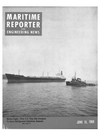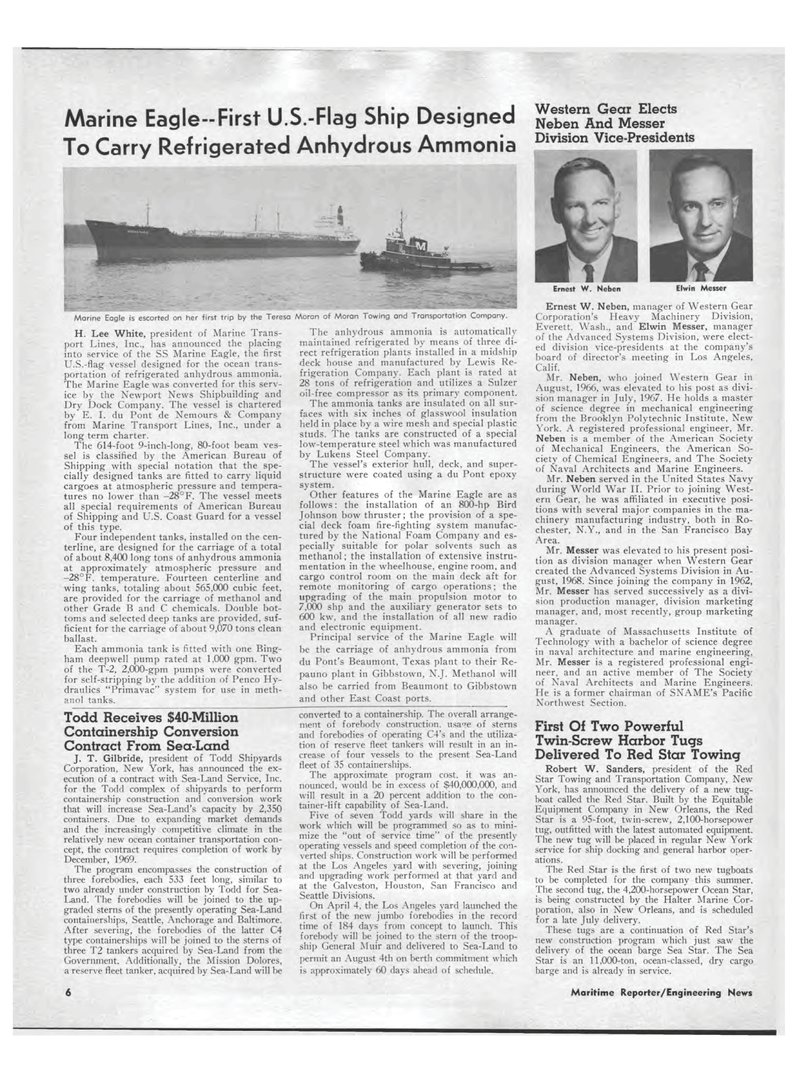
Page 4: of Maritime Reporter Magazine (June 15, 1969)
Read this page in Pdf, Flash or Html5 edition of June 15, 1969 Maritime Reporter Magazine
Marine Eagle--First U.S.-Flag Ship Designed j^be^AndMessef5 To Carry Refrigerated Anhydrous Ammonia Division Vice"Pre!^!± Marine Eagle is escorted on her first trip by the Teresa Moron of Moran Towing and Transportation Company. Ernest W. Neben Elwin Messer H. Lee White, president of Marine Trans-port Lines, Inc., has announced the placing into service of the SS Marine Eagle, the first U.S.-flag vessel designed for the ocean trans-portation of refrigerated anhydrous ammonia. The Marine Eagle was converted for this serv-ice by the Newport News Shipbuilding and Dry Dock Company. The vessel is chartered by E. I. du Pont de Nemours & Company from Marine Transport Lines, Inc., under a long term charter. The 614-foot 9-inch-long, 80-foot beam ves-sel is classified by the American Bureau of Shipping with special notation that the spe-cially designed tanks are fitted to carry liquid cargoes at atmospheric pressure and tempera-tures no lower than -28° F. The vessel meets all special requirements of American Bureau of Shipping and U.S. Coast Guard for a vessel of this type. Four independent tanks, installed on the cen-terline, are designed for the carriage of a total of about 8,400 long tons of anhydrous ammonia at approximately atmospheric pressure and -28°F. temperature. Fourteen centerline and wing tanks, totaling about 565,000 cubic feet, are provided for the carriage of methanol and other Grade B and C chemicals. Double bot-toms and selected deep tanks are provided, suf-ficient for the carriage of about 9,070 tons clean ballast. Each ammonia tank is fitted with one Bing-ham deepwell pump rated at 1,000 gpm. Two of the T-2, 2,O0O-gpm pumps were converted for self-stripping by the addition of Penco Hy-draulics "Primavac" system for use in meth-anol tanks. Todd Receives $40-Million Containership Conversion Contract From Sea-Land J. T. Gilbride, president of Todd Shipyards Corporation, New York, has announced the ex-ecution of a contract with Sea-Land Service, Inc. for the Todd complex of shipyards to perform containership construction and conversion work that will increase Sea-Land's capacity by 2,350 containers. Due to expanding market demands and the increasingly competitive climate in the relatively new ocean container transportation con-cept, the contract requires completion of work by December, 1969. The program encompasses the construction of three forebodies, each 533 feet long, similar to two already under construction by Todd for Sea-Land. The forebodies will be joined to the up-graded sterns of the presently operating Sea-Land containerships, Seattle, Anchorage and Baltimore. After severing, the forebodies of the latter C4 type containerships will be joined to the sterns of three T2 tankers acquired by Sea-Land from the Government. Additionally, the Mission Dolores, a reserve fleet tanker, acquired by Sea-Land will be The anhydrous ammonia is automatically maintained refrigerated by means of three di-rect refrigeration plants installed in a midship deck house and manufactured by Lewis Re-frigeration Company. Each plant is rated at 28 tons of refrigeration and utilizes a Sulzer oil-free compressor as its primary component. The ammonia tanks are insulated on all sur-faces with six inches of glasswool insulation held in place by a wire mesh and special plastic studs. The tanks are constructed of a special low-temperature steel which was manufactured by Lukens Steel Company. The vessel's exterior hull, deck, and super-structure were coated using a du Pont epoxy system. Other features of the Marine Eagle are as follows: the installation of an 8O0-hp Bird Johnson bow thruster; the provision of a spe-cial deck foam fire-fighting system manufac-tured by the National Foam Company and es-pecially suitable for polar solvents such as methanol; the installation of extensive instru-mentation in the wheelhouse, engine room, and cargo control room on the main deck aft for remote monitoring of cargo operations; the upgrading of the main propulsion motor to 7,000 shp and the auxiliary generator sets to 600 kw, and the installation of all new radio and electronic equipment. Principal service of the Marine Eagle will be the carriage of anhydrous ammonia from du Pont's Beaumont, Texas plant to their Re-pauno plant in Gibbstown, N.J. Methanol will also be carried from Beaumont to Gibbstown and other East Coast ports. converted to a containership. The overall arrange-ment of forebody construction. usa

 3
3

 5
5
